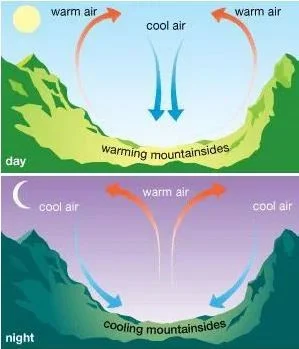When sailing close to coastlines or hill country, it is not unusual to get caught out by an unexpected gust either blowing up a slope or sweeping down unexpectedly. They are not random – they’re part of the natural wind systems called anabatic and katabatic winds. If you find yourself sailing in these areas, learning about the way these winds work can assist you in expecting changes in conditions and making improved decisions on watch.
What are Anabatic Winds?
Anabatic winds, or upslope winds, are local daytime winds blowing uphill. Here’s why they happen:
During the day, the mountain slopes warm faster than the air around them.
As the air warms and rises, it pulls cooler air from the valley below to take its place.
This upward movement of air along the slope is called an anabatic wind.
They are usually mild, but in mountainous areas, especially in the tropics, they can become quite strong.
Where Might You Find Them?
– Mountain coastlines
– Highland islands
– Fjords or steep valleys near the ocean
What Are Katabatic Winds?
Conversely, katabatic winds (or downslope winds) develop at night when air over mountain tops cools rapidly:
As the sun goes down, high ground rapidly loses heat.
Cold, heavy air starts descending the slopes under the power of gravity.
This causes strong, frequently cold winds to come down into the valleys or along the coastal regions below.
Katabatic winds may vary from light breezes to extremely strong gusts, particularly in polar areas such as Antarctica or Greenland, where intense and long-lasting cold air masses exist.
Maritime Practical Importance to Mariners
As a mariner, these winds will not appear on synoptic weather maps but can affect ship handling considerably, particularly under conditions of manoeuvring off shore:
Anabatic winds may influence small vessels or lifeboat launching operations in mountainous anchorages.
Katabatic winds are unpredictable, driving ships onto the coast or anchoring with difficulty as a result of sudden forceful gusts.
Knowing these local wind patterns makes you anticipate micro-weather occurrences, particularly when radar and instruments indicate open skies but the weather is changing rapidly.
Final Words
While open-sea sailing is taken over by big-scale winds, it’s the local winds such as anabatic and katabatic flows that catch sailors by surprise when they’re close to shore. Knowing how the earth affects air movement during the day and night can be helpful, whether you’re anchoring near a cliff wall or sailing in a fjord. The next time you catch a whirlwind when the skies are blue, you’ll know what’s happening..


